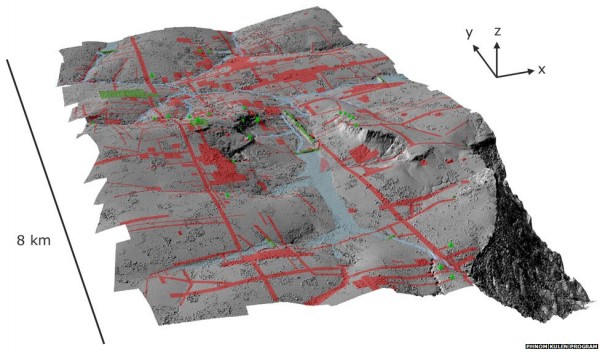In Cambodia, A Lost City Is Found
| David Perry | | Sep 23, 2014 01:51 AM EDT |
(Photo : Phnom Kulen Program) The ancient royal city of Mahendraparvata was little more than a legend until modern technology spotted it.
Archeologists working in the Southeast Asian nation of Cambodia announced the discovery of a city once thought to be legend.
The nation is most famous for Angkor, the illustrious capital of Khmer Empire, that rose near the Tonle Sap Lake around 1150 AD. But a rare few inscriptions tell of another, older city called Mahendraparvata that may be the true birthplace of Khmer culture. But nobody knew where it was.
Like Us on Facebook
Until now.
Archeologists flew over a plateau northeast of Angkor called the Kulen Hills using lidar, a technology that strips away otherwise impenetrable vegetation. The region is mentioned as the site of Mahendraparvata, but is so vast and so over grown by near-impenetrable rain forests that work on the ground would have taken years.
Before the survey team's eyes, a neat grid of streets and boulevards appeared out of the jungle, dotted with temples, man-made ponds, and evidence of hydraulic architecture that is the hallmark of Angkor's dazzling water-controlling civilization.
Even more impressive, the street grid defied geography; roads and ceremonial pathways cut straight through hills and dales across the plateau.
"You have this kind of sudden eureka moment where you bring the data up on screen the first time and there it is - this ancient city very clearly in front of you," said Dr. Damian Evans of the University of Sydney in Australia, who led the lidar survey.
Mahendraparvata is thought to have been founded in the 9th Century by King Jayavarman II, 300 years before Angkor is estimated to have risen.
At its height in the late 1100s, Angkor, whose temples of Angkor Wat and Angkor Thom are among the planet's most iconic of antiquities, stretched over 1,000 square miles. Angkor controlled an empire spanning all of modern Cambodia, as well as parts of Thailand, Laos, Vietnam, and Myanmar.
Since its invention, lidar went from a scoffed-at technology to one of the most sought-after tools in modern archeology. Shooting a series of lasers bursts every four seconds, lidar "sees" through vegetation to detect minute changes on the forest floor, making it invaluable for contour maps as much as archaeology.
In addition to re-discovering Mahendraparvata, lidar proved instrumental in pinpointing lost Mayan cities in Central America and colonial sites in Canada.
Dr. Evans and his team also scanned the regions immediately around Angkor itself, discovering a spectacularly intricate man-made landscape of canals and holding ponds that to the naked eye today appears as empty fields.
By harnessing the water provided by the monsoon, the Khmer were able to feed a huge population that turned Angkor into the largest city in the medieval world.
It is thought that Mahendraparvata and Angkor fell and faded away from history at the same time, in the 15 Century, when a global cooling period called the Little Ice Age triggered catastrophic droughts across the Southeast Asia.
The Little Ice Age collapsed the cities' waterworks and triggered famine. Khmer kings then moved their seat to the present Cambodian capital of Phnom Phenh.
TagsMahendraparvata, Cambodia, Angkor, Angkor Wat
©2015 Chinatopix All rights reserved. Do not reproduce without permission
EDITOR'S PICKS
-

Did the Trump administration just announce plans for a trade war with ‘hostile’ China and Russia?
-

US Senate passes Taiwan travel bill slammed by China
-

As Yan Sihong’s family grieves, here are other Chinese students who went missing abroad. Some have never been found
-

Beijing blasts Western critics who ‘smear China’ with the term sharp power
-

China Envoy Seeks to Defuse Tensions With U.S. as a Trade War Brews
-

Singapore's Deputy PM Provides Bitcoin Vote of Confidence Amid China's Blanket Bans
-

China warns investors over risks in overseas virtual currency trading
-

Chinese government most trustworthy: survey
-

Kashima Antlers On Course For Back-To-Back Titles
MOST POPULAR
LATEST NEWS
Zhou Yongkang: China's Former Security Chief Sentenced to Life in Prison

China's former Chief of the Ministry of Public Security, Zhou Yongkang, has been given a life sentence after he was found guilty of abusing his office, bribery and deliberately ... Full Article
TRENDING STORY

China Pork Prices Expected to Stabilize As The Supplies Recover

Elephone P9000 Smartphone is now on Sale on Amazon India

There's a Big Chance Cliffhangers Won't Still Be Resolved When Grey's Anatomy Season 13 Returns

Supreme Court Ruled on Samsung vs Apple Dispute for Patent Infringement

Microsoft Surface Pro 5 Rumors and Release Date: What is the Latest?










